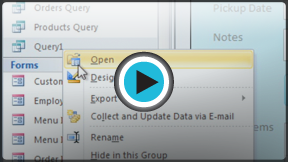
Access 2010
Managing Databases and Objects
Introduction
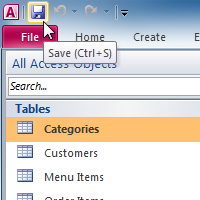
Each Access database consists of multiple objects that let you interact with data. Databases can include forms for entering data, queries for searching within it, reports for analyzing it, and of course, tables for storing it. Whenever you work with your database, you are working with many of these objects at once. Fortunately, Access makes managing these objects pretty easy.
In this lesson, you will learn how to to open and close databases, as well as how to open, close, and save objects.
Throughout this course, we will be using a sample database. If you would like to follow along, download our example and use it to follow the procedures demonstrated in this lesson.
Opening and closing databases
Before you enter data or otherwise modify your objects, you will have to open your database. After you've made changes to your database, you'll need to know how to close it.
To open an existing database:
- Click the File tab. This takes you to Backstage view.
- Select Open. A dialog box will appear.
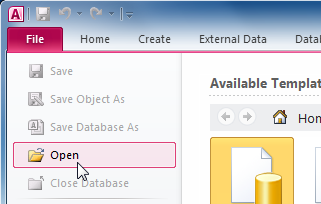 Opening a database
Opening a database - Locate and select the desired database, then click Open.
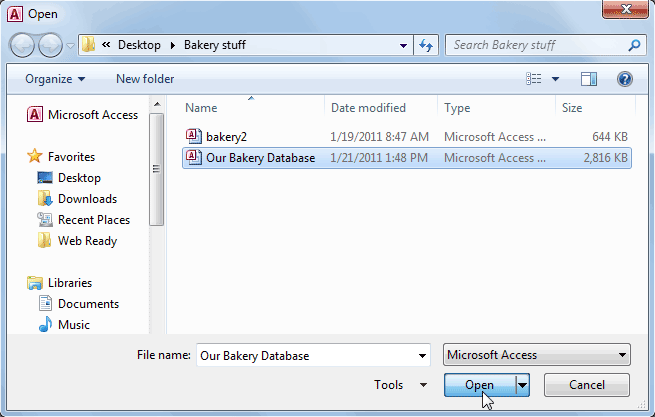 Selecting a database to open
Selecting a database to open - One or more warning messages may appear when you open your database.
- If the database contains customized functions, a yellow bar with a security warning may appear below the Ribbon. If you trust the source of your database, click Enable Content for your database to display correctly.
 Enabling customized functions and other content for the database
Enabling customized functions and other content for the database - After enabling all content in the database, you may see a message asking if you want to make the database a Trusted Document. Click Yes if you would like all content to be automatically enabled each time you open the database.
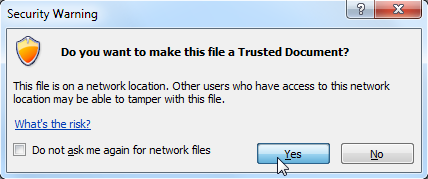 Choosing to make the file a Trusted Document
Choosing to make the file a Trusted Document - You may be prompted to Log In to the database. Select your name from the log in list. If your name does not appear, click Add User to enter your information.
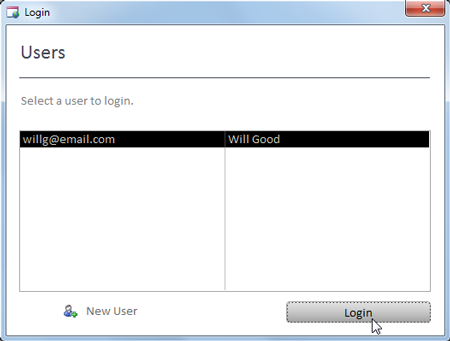 Logging in to a database
Logging in to a database
- If the database contains customized functions, a yellow bar with a security warning may appear below the Ribbon. If you trust the source of your database, click Enable Content for your database to display correctly.
If you have opened the existing database recently, it may be easier to look for your database in the short list that appears in the sidebar or to select Recent and choose a database from the list that appears.
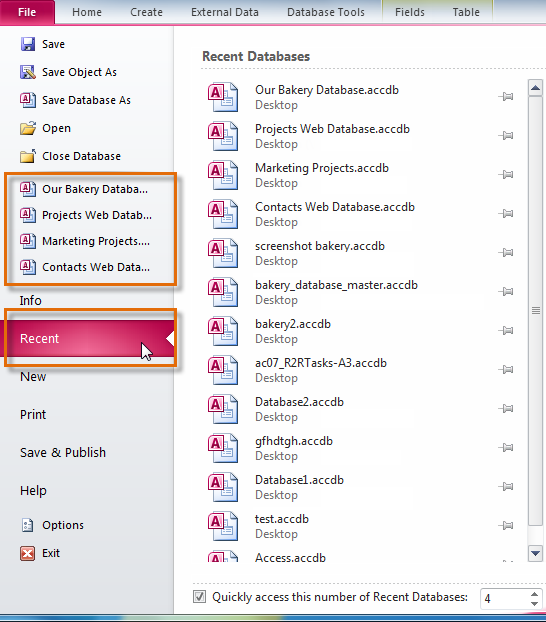 Opening a recently opened database
Opening a recently opened database To close a database:
- Click the File tab to go to Backstage View.
- Select Close Database.
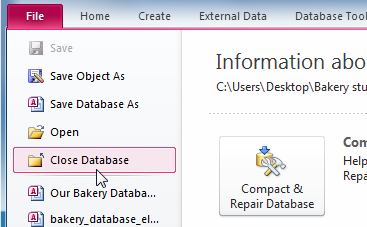 Closing a database
Closing a database - If you have any unsaved objects, a dialog box will pop up for each one asking if you would like to save it. Select Yes to save the object, No to close it without saving, or Cancel to leave your database open.
 Saving changes to unsaved objects
Saving changes to unsaved objects
Working with objects
It's helpful to think of your database as a large binder or folder in which you store your data. The data itself is contained in database objects. Access 2010 treats each of these objects as separate documents, which means you will have to open and save them individually in order to work with them.
You may have noticed that this lesson contains no instructions for saving a database. That's because you cannot save an entire database at once. Rather, you must individually save the objects contained within the database.
To open an object:
- In the Navigation Pane, locate the object you would like to open.
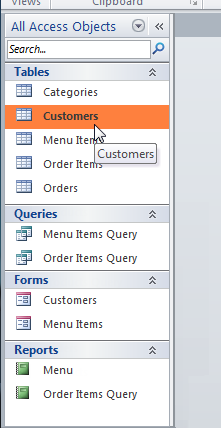 Selecting an object in the Navigation Pane
Selecting an object in the Navigation Pane - Double-click the desired object. It will open and appear as a tab in the Document Tabs bar.
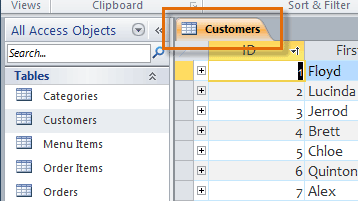 The newly opened object in the Document Tabs bar
The newly opened object in the Document Tabs bar
By default, the most recently opened object will display in the main window as the current object. To view another open object, simply click its tab in the Document Tabs bar.
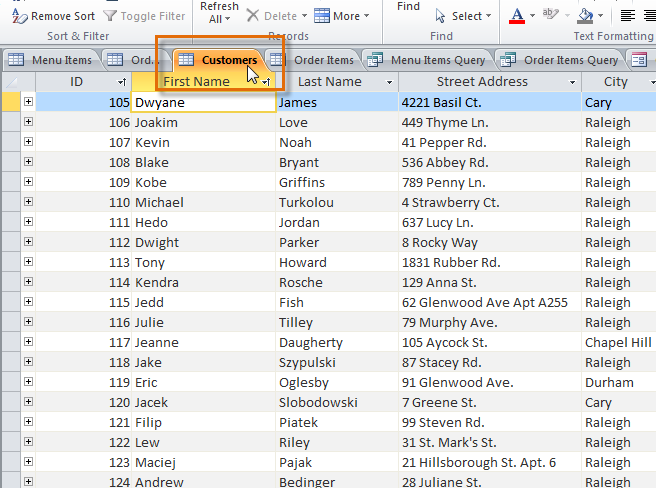 The currently open object
The currently open objectSaving objects
As in other Microsoft Office programs, you will be prompted to save any unsaved work when you attempt to close your database. However, it is a good idea to save your work as you go along. Saving your work often is the best way to ensure you don't lose any information if your computer crashes.
To save a new object:
- Select the object you wish to save by clicking its tab in the Document Tabs bar.
- Select the File tab to navigate to Backstage View.
- Click Save.
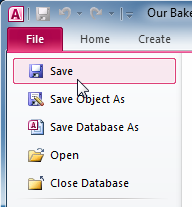 Saving a new object in Backstage View
Saving a new object in Backstage View - The first time you save an object, you will be prompted to name it. Enter the desired object name, then click OK.
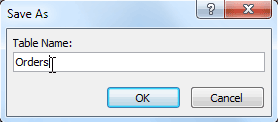 Naming a new table
Naming a new table
To save an existing object, select save in Backstage View, or simply click the Save command in the Quick Access Toolbar.
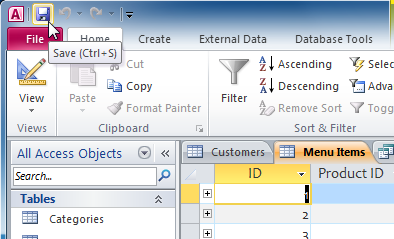 Saving the current object with the Quick Access Toolbar
Saving the current object with the Quick Access ToolbarTo close an object:
- Select the object you wish to close on the Document Tabs bar.
- Click the
 on the far right of the Document Tabs bar.
on the far right of the Document Tabs bar.
 Closing the current object
Closing the current object - If there are any unsaved changes to the object, you will be prompted to save it. Select Yes to save, No to close it without saving your changes, or Cancel to leave the object open.
You can also close an object by right-clicking its tab on the Document Tabs bar. A drop-down menu will appear. Select Close to close that object, or Close All to close all open objects.
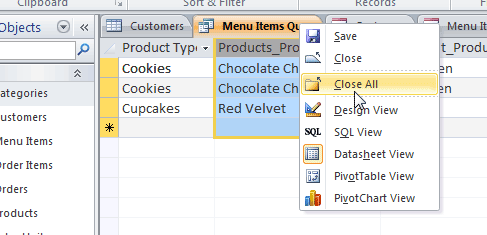 Closing all open objects
Closing all open objectsTo rename an object:
- If the object you wish to rename is open, close it.
- In the Navigation Pane, right-click the object you would like to rename.
- Select Rename.
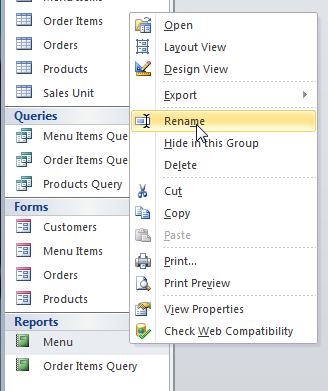 Renaming an object
Renaming an object - Type the new name, then press Enter.
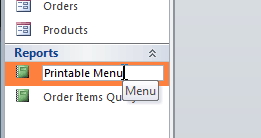 The renamed report
The renamed report
Challenge!
- Open Access 2010 on your computer, and open an existing database. If you want, you can use our sample database.
- Open an object.
- Close the object.
- Rename the object.
- Close the database without saving your changes.
